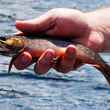America’s public domain was saved from the excesses of business by visionaries. It was set aside for all the people. That’s how it should remain.
It was the culmination of nearly three centuries of the pursuit of profit. What began in tiny enclaves along the east coast marched steadily out into the unexplored continent, consuming land and people as it went, until it reached the prairies and high county of the West. Our myth has it that the process was driven by stalwart men and women yearning to breathe free, but they were only pawns in the great game. From the very beginning, the process was driven by corporate investment, often with immense government backing, and by the time it reached the Rockies, it had developed into a well-oiled machine.
It began with fur. The myth whispers tales of dauntless men in buckskins braving the wilderness, but the reality was corporate. Giant firms like the Hudson’s Bay Company and the American Fur Company controlled the business, providing the trade goods and transporting the take to markets in Britain and Europe. Before they were finished, the beaver had practically disappeared, and the bison teetered on the edge of extinction.
Then came the miner, not the bearded sourdough of legend, but corporate giants like Anaconda, Homestake, and Phelps Dodge, outfits that had the capital to chase the mineral lodes and the influence to dodge the liability for the damage they did in the process. They poisoned streams, stole millions of board feet of timber from the public domain, and provided an insatiable demand for the wild meat provided by local market gunners.

After that, the Union Pacific and Central Pacific and Northern Pacific arrived on the scene, the companies that tied the nation together with steel, and at the same time, stripped the mountains of timber, corrupted a generation of U.S. Congressmen and state officials, and maneuvered the government into funding schemes so ruinous that they triggered the Panic of 1873 and nearly ten years of the worst depression the nation had ever seen.
The rangelands were not spared. The myth of the cowboy hides the reality of the cattle baron. Backed by millions of dollars from investors as far away as Great Britain and Scotland, these entrepreneurs defrauded the federal government and the American people of millions of acres of land through criminal abuses of the Homestead Act. They illegally claimed millions more acres of the public domain, and when the law wasn’t enough to exclude small-time operators, they occasionally hired gunmen to shoot them down. By the time they had finished, the range had been severely overgrazed and the cheatgrass disaster had gained a foothold in the Great Basin.
C.A. Smith, Frederick Weyerhauser, and their competitors used similar tactics to lay claim to huge tracts of pristine timber in the Northwest, finishing the assault on western forests that the railroads and mining companies had begun.
This was the western landscape at the close of the nineteenth century: a land controlled and operated by millionaires and conglomerates, many of whom had stretched the law or simply flouted it to control the economy and politics of the public domain. A land stripped of its pristine promise: the range overgrazed; the forests over-cut; mountainsides raw and bleeding from the pitiless extraction of precious metals; streams polluted; the great herds of game, the beaver, the sage grouse all but extinct.

The entire nation was appalled. The people of the United States were still firmly committed to the ideals of personal freedom and entrepreneurship, but they had seen enough of the abuse of public lands in the West. Faced with the ruin wrought by an unfettered market and a moneyed elite, a generation of Americans began looking for a different way to realize the democratic ideal in the arid West.
The movement proceeded from the notion that our common interest is sometimes best served when we own certain things together. The idea of places and resources held in the public trust gained traction with wildlife in the 1840s and was extended over the next century to the great open spaces of the West’s public domain. It gained momentum with the creation of the world’s first national park in 1872 and continued with the establishment of the first national forest on the eastern edge of Yellowstone National Park in 1891. By the time Theodore Roosevelt became president in 1901, the nation was already well on the road to a different approach.
Gifford Pinchot, one of Roosevelt’s closest friends and advisors, is widely credited with providing Roosevelt with the concept of wise use of the land, particularly federal land, and a term for that sort of sustainable use: conservation. Roosevelt was not only an enthusiastic advocate for wildlife and wild land, he was also a consummate politician. He recognized the value of conservation as a middle ground between the destructive land use policies of the nineteenth century and the preservationist reaction to those abuses by men like John Muir.
A handful of local interests, often backed by corporate money and influence, were loud in their opposition to the concepts of national forests and grazing lands that men like Roosevelt championed, but the nation as a whole supported the idea of federal reserves and the sustainable use of natural resources on those reserves.
Of course, the devil is always in the details. The definition of “wise use” of public lands has been argued ever since it became a tenet of federal management with the passage of the Forest Service Organic Act in 1897. In 1960, the concept officially morphed into “multiple use,” a phrase that may be even less useful in defining the details of federal land management than its predecessor.

That was the year I first came west. I was only nine, far too young to be aware of the battles that had kept the public domain open to me or of the fights that continued over management of those lands. All I knew was that I could go as far as my legs could take me, up to the highest ridge and on to the far horizon. When I was tired, I could pick out any tree to lean against without asking an owner’s permission, a privilege I had learned to do without in the settled country around my home in Illinois. When I was thirsty, I could lie down on a gravel bar and drink my fill out of the creek, the crystal water ever so slightly flavored by the granite over which it ran, so cold it made my teeth ache. Although I didn’t know it at the time, this tiny freedom was one of the first I would have to sacrifice in the name of multiple use.
As the years have gone by, there have been other sacrifices. I’ve seen herds of elk run out of entire drainages in wilderness areas, evicted by the flocks of domestic sheep cleaning up the grazing allotment. I’ve seen vast basins where herds of deer and pronghorn once prospered now filled with oil derricks and seamed with roads. I’ve watched bighorn sheep melt away under the insidious onslaught of diseases carried to them by domestic livestock. I’ve watched public rangeland deteriorate under the combined grazing pressure of cattle and feral horses. I’ve witnessed the steady decline of the greater sage grouse, an icon of the West’s sagebrush grasslands, and the mule deer, perhaps the West’s most treasured big game animal. I’ve come around the corner of a rocky sagebrush ridge to find the exquisite silence broken by a steady pulse of sound at such low frequency that it is felt more than heard— the sound of a wind turbine’s blades flailing the air a mile away.
Multiple use. It’s a politician’s phrase. It subtly implies that we can “have it all” on the public domain, that the interests of commerce and the common man can be allowed to overlap infinitely on every square mile of our forests and range. Anyone who has spent time on public land in the West knows that is not true, cannot be true.
The open spaces and the wildlife they support are the future of the region, infinitely more sustainable and ultimately far more valuable than minerals, energy, or livestock. The governor of Wyoming recently reacted to the downturn that currently grips his state, the last bust in a long succession of energy booms and busts, by appointing a panel of experts to recommend ways to diversify the state’s economy. It’s instructive that the committee did not include a single person with an interest in wildlife or wild land and only one person whose title indicates that she is involved in agriculture. Not surprisingly, the committee’s preliminary report barely mentioned tourism and outdoor recreation, the state’s second largest industry, and failed to make any recommendations that would have enhanced open spaces, wild land, wildlife, or recreational access.
At the same time, the saga of the Cliven Bundy clan and its assault on public control over the public domain has finally come to an end, with no action taken against the Bundys. A new precedent has apparently been set in which a lessee on public land can ignore public management plans, flout federal court orders, and threaten public employees at gunpoint.
And, in spite of promises from the current administration, the Republican Party platform specifically recommends that the public domain be turned over to the states where the choicest pieces will almost certainly be sold to the highest bidder. While the White House denies that it has any plans to advance this agenda, conservatives like Utah’s Rob Bishop, with the help of huge corporate funding through the American Lands Council and other front groups, continue to pursue the goal of dismantling federal holdings in the West.
The form and function of the consensus on federal land management have been hammered out in often acrimonious debate over the last hundred years. They have changed with time, and they will continue to change as the people who care about the public domain change, and as the land itself changes. Finding consensus among 300 million citizens is always a challenge, and it is especially difficult when we look for consensus on managing public land in the West.
But neither history nor recent experience supports the notion that these lands would better serve America if they were in state ownership or private hands, nor does it suggest that the public would benefit if we removed the current regulatory framework or further eroded enforcement of those regulations.
The demands big business continues to make on the public domain in the West haven’t changed; they’ve been held in check only by federal regulations that seek to control the management of national forests and BLM holdings.
If these lands were to be given to the states or sold to private interests, these smaller governing entities or owners would not have the power to resist the influence the corporations wield. Even the federal government struggles to resist that influence. Land use would quickly return to the patterns that developed in the nineteenth century. The resources on the public domain, renewable and nonrenewable, would be sacrificed to enhance profits and the public would lose its right to visit what was left.
These days, nearly all Americans are dispossessed, confined in our apartments, on our quarter-acre lots, estranged from the land that, in large part, has defined our character as a people and a nation. We are held prisoner by economics. One of the few physical expressions of freedom we have left is the public domain. Together, we can use it without destroying it; we can enjoy it without dividing it.
We should never give it up.
































Comments
Kate Beardsley replied on Permalink
The passion, thoroughness, and ultra-high-altitude view of our situation expressed by this author makes this piece by Chris Madson my new favorite to share. Only we - together - can prevent future calamities. Exceptionally excellent - I will share far and wide! Thank you, Hatch, for publishing.
Kevin replied on Permalink
A president once said “the chief business of the American people is business.” There’s a lot of truth in that, although it’s not the whole picture.
People owning and running large and small businesses have always looked at public lands as a resource that they can use in their businesses. That’s true if it’s an oil producer looking for oil, or a rancher looking to graze his or her cattle, or Patagonia looking to sell its merchandise, or a fly shop owner or guide promoting his or her business. You can romanticize some users and demonize other users.
We set aside some public lands for specific uses and exclude all other uses. Think of a national park or a military gunnery range. But we have wisely chosen “multiple use” as the default setting for a lot of federal land.
You may like special use restrictions that favor your favorite use - whether it’s resource extraction or timber harvesting or grazing or sport fishing or habitat preservation for some particular species - or you may not like those restrictions if they limit or preclude your favorite use. But our land managers have guidelines and rules that cause them to manage them according to what our government believes is a proper balance.
All users of the public lands should pay for that use. We like to hear that the government collects royalties from oil & gas extraction, but we don’t like to pay user fees for recreation. But everyone should pay.
I don’t think the federal government is a better or worse steward of public land than states or local governments. I can point to examples of good and bad management in lots of places. But the closer the government is to the affected people, the more likely it is to be responsive to those people. State control is no guarantee of wisdom - my state of California has sometimes managed well and sometimes not. The same will be true for your state.
Narrow special users - like we fly fishers - need to keep the bigger picture in mind.
Renee replied on Permalink
Beautifully written. Thank you
Tim Bruno replied on Permalink
Public lands need to remain public. As a culture we’ve done enough damage and we need to remember that extinction is forever.
Maggie Frazier replied on Permalink
"Visionaries"? Thats certainly one word for it - I can think of several more - destructive, greedy, profit driven? Their only "vision" is money! And that hasnt changed in all these years. This is the same vision that has brought us to the brink of global warming. I do disagree with the idea that the "feral" horses are partnering with livestock in the destruction of the range. Thats the livestock industry's story. Comparing a few thousand wild horses to the millions of cattle & sheep? Believe me, the livestock lobby is salivating at the idea of eradicating WILD horses. The horses have been robbed of thousands of acres that used to be herd managment areas. And, to be honest, they would just as soon eliminate all wild predators - as was done hundreds of years ago. Looking at the picture of those buffalo skulls makes me sick - but buffalo are in almost as much danger today from the livestock industry - check out the slaughter every year near Yellowstone!
Alan Davis replied on Permalink
I'm sorry but the statement: "...I do disagree with the idea that the "feral" horses are partnering with livestock in the destruction of the range..." Shows an unfamiliarity with the problem. Fortunately, you did use feral and not "wild" as many of the feral horse supporters are want to do. Particularly in Arizona, these feral horses destroy habitat for birds, fish, and mammals. They eat the grasses and vegetation other mammals forage upon; they destroy the nesting areas for many birds, and they destroy the delicate riparian areas along rivers and streams where they water. Their excrement creates breeding areas for all types of insects that infect humans, birds, and fish as they destroy the water quality, and thus the ability of higher quality insect survival, e.g., mayflies, stoneflies, caddis, etc.
Thank you no, I don't want feral horses on public lands.
Pages